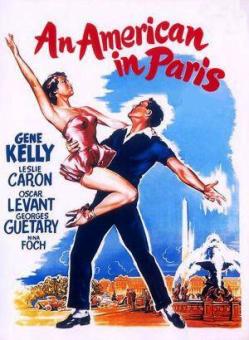Aidan Curran posted on April 24, 2009 19:00
The
Champs-Élysées runs up to one side of the Arc de Triomphe, and down the opposite side is the Avenue de la Grande Armée, down as far as Porte Maillot and the bus out to Beauvais airport. This street attracts less tourists, perhaps because you’ll mainly see motorcycle showrooms here.
But back in 1928 those showrooms sold cars and at least one American tourist passed by. So the story goes, the visitor stopped at dealerships along the Avenue de la Grande Armée and honked the bulb horns on various cars. The garage-owners’ reactions haven’t been recorded for posterity – just the honking, which you can hear on a piece of music this passer-by, George Gershwin, subsequently wrote. (Strictly speaking, Gershwin wasn’t a tourist – already famous, he had come to Paris to immerse himself in the city’s music scene.)

Instead of a miniature
Eiffel Tower or carefully-stashed bottle of wine, Gershwin’s Paris souvenirs were those car horns – he brought back several to New York and added them to the orchestra for the première of ‘An American In Paris’ in December 1928. The idea of the horns was to add to an overall mood of being in Paris, what one would hear while strolling along the boulevards. (Car horns still hog the ambient noise in this city, Parisian drivers being as impatient as they are reckless.)
As the circus-like parping of bulb horns suggests, ‘An American In Paris’ is more whimsical than Gershwin’s masterpiece, the epic ‘Rhapsody In Blue’. But that’s just as accurate a representation of being a U.S. ex-pat in 1920s Paris. The title of Ernest Hemingway’s definitive account of this time and place, ‘A Moveable Feast’, gives an idea of the dynamism and socialising on display. The likes of Gertrude Stein held court here, attended on by Hemingway, F. Scott Fitzgerald and Henry Miller – and Josephine Baker’s cabaret show caused a sensation. (
James Joyce was also here, of course, soon to be joined by a young assistant called Samuel Beckett.)
‘An American In Paris’ inspired
the 1951 Hollywood musical of the same name, starring Gene Kelly. The composer was already dead, so the film features existing songs by him and his lyricist brother Ira, like
‘I Got Rhythm’ and ‘’S Wonderful’. The centerpiece of the film is an 18-minute dance sequence to an arrangement of Gershwin’s ‘An American In Paris’, in which a daydreaming Kelly passes through scenes from various styles of French painting.
Despite Kelly being in top form, the musical is contrived and unengaging. (What’s more, its Paris scenes were filmed on Hollywood sets and the ‘Parisian’ supporting characters speak very stilted French.) Still, the film beat Brando’s ‘A Streetcar Named Desire’ to win that year’s Oscar for Best Picture. It also won two Oscars for its music, but these went to the arrangers rather than posthumously to Gershwin. (‘Rhapsody In Blue’ would also inspire a celebrated film: it features in
the opening sequence of Woody Allen’s ‘Manhattan’.)
Gershwin’s composition was back in the news in 2008 when the New York Philharmonic played it during their historic performance in North Korea. Unfortunately, we won’t know what Kim Jong-Il thought of this slice of Franco-American frivolity; the North Korean leader didn’t show up for the concert. (Nonetheless, we have a disturbing mental image of Kim Jong-Il honking the bulb horn of his old-fashioned jalopy driving through Pyongyang.)
Here's the New York Philharmonic with the liveliest thing to hit North Korea since someone invented a new shade of grey back in 1958. Note how the bulb horn part goes to the young guy with the funkiest haircut (37 secs) - a recent graduate on that instrument, no doubt:
More ...
[Read More...]